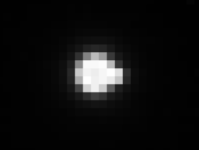lpetrich
Contributor
NASA launches Parker Solar Probe toward the sun - YouTube, NASA, ULA Launch Parker Solar Probe on Historic Journey to Touch Sun | NASA
It was launched by a Delta IV Heavy rocket on 3:31 AM EDT from Cape Canaveral, a day after the scrubbing of its previous launch attempt.
Heliophysics pioneer watches Liftoff of Parker Solar Probe | NASA -- Dr. Eugene Parker himself, after whom the spacecraft was named.
Parker Solar Probe describes the spacecraft in detail. It is to approach to a distance of 9 solar radii from the Sun's center or 0.04 AU, thus giving it a chance to sample the Sun's outer corona, where the corona fades off into the solar wind. This will be much closer than any previous spacecraft has gone. Helios A and Helios B both reached 0.3 AU, closer than planet Mercury, and the previous record for proximity to the Sun.
The PSP will have a carbon-composite sunshield that will get as hot as 2500 F / 1400 C at closest approach -- hot enough to glow. Its solar panels will folded inward, being shaded by the sunshield, at closest approach, and unfolded outward when farther away.
The PSP will do 24 orbits over its mission, and it will receive 7 gravity assists from Venus flybys. Its first flyby will be on October 2, and its first perihelion on November 5 at 36 solar radii or 0.17 AU. It will do a few orbits, then fly by Venus again, then repeat until it is in its final orbit. In that orbit, its perihelion will be as close as the PSP will get to the Sun, while its aphelion will be at Venus's orbit, about 0.72 AU away.
It was launched by a Delta IV Heavy rocket on 3:31 AM EDT from Cape Canaveral, a day after the scrubbing of its previous launch attempt.
Heliophysics pioneer watches Liftoff of Parker Solar Probe | NASA -- Dr. Eugene Parker himself, after whom the spacecraft was named.
Parker Solar Probe describes the spacecraft in detail. It is to approach to a distance of 9 solar radii from the Sun's center or 0.04 AU, thus giving it a chance to sample the Sun's outer corona, where the corona fades off into the solar wind. This will be much closer than any previous spacecraft has gone. Helios A and Helios B both reached 0.3 AU, closer than planet Mercury, and the previous record for proximity to the Sun.
The PSP will have a carbon-composite sunshield that will get as hot as 2500 F / 1400 C at closest approach -- hot enough to glow. Its solar panels will folded inward, being shaded by the sunshield, at closest approach, and unfolded outward when farther away.
The PSP will do 24 orbits over its mission, and it will receive 7 gravity assists from Venus flybys. Its first flyby will be on October 2, and its first perihelion on November 5 at 36 solar radii or 0.17 AU. It will do a few orbits, then fly by Venus again, then repeat until it is in its final orbit. In that orbit, its perihelion will be as close as the PSP will get to the Sun, while its aphelion will be at Venus's orbit, about 0.72 AU away.

